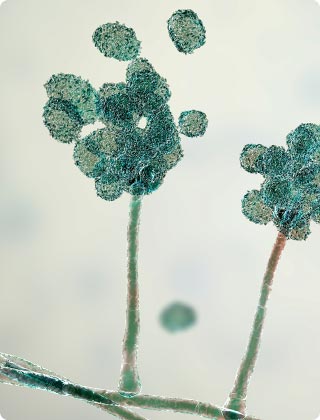MENU

Stachybotrys chartarum, known as toxic black mold or simply black mold, is one of the most dreaded types of mold. And not without just cause!
This mold produces mycotoxins which could pose serious issues to your health. It could lead to respiratory problems and a serious case of allergies. Yes, Stachybotrys chartarum is dangerous. However, the truth is many people don't know the facts about it.
Is it like every other type of mold? Are its health effects worse? How do you know if the black stain on your wall is Stachybotrys Chartarum? We have taken the time to answer these questions as we provide you with seven facts on this toxic black mold.

Stachybotrys chartarum (Stachybotrys atra) has been highly sensationalized in the media. It got the name - toxic black mold and most people started to paint it as the most dangerous thing you might see in your home. The lines of fact and fictional imaginations began to blur.
Things like the true color of the mold which is more greenish-black than black took the back seat. But, we are here to demystify this mold. Some of these facts might even contradict what you were told before. However, it is the truth about Stachybotrys chartarum. Let's get right into it!
Stachybotrys chartarum can cause damage to your lungs and other organs, as well as causing symptoms like headaches, and queasiness. How it leads to all these health issues is its mycotoxins. Mycotoxins are found in Stachybotrys spores.
Mycotoxins are tiny toxins that can affect your health if inhaled or ingested. Stachybotrys is not the only mold that produces these toxins though. It can be found in Penicillium, Alternaria, and Aspergillus.
Note that Stachybotrys doesn't always release its toxins. It requires certain conditions for the release of toxins.
The number of people that have died from Stachybotrys chartarum related issues cannot be proven yet. There have not been any studies that show the direct relationship between exposure to Stachybotrys and any health issue.
However, long-term exposure to high levels of this mold has been seen to lead to complications that result in death. Infants exposed to it developed pulmonary hemosiderosis (bleeding in lungs). Health problems related to toxic black mold have been documented since the 1930s in humans and animals.
It is also associated with the sick building syndrome. Though, there has not been concrete scientific literature to prove it. While the exact number to have died has not been properly documented, science shows without a doubt that this mold is dangerous. You must take immediate steps to remove it if found in your home.
Many are often under the impression that Stachybotrys chartarum spreads like wildfire. The fact is the opposite is the case. Stachybotrys has a tacky texture which keeps it pretty much stagnant in the place it starts to grow.
Stachybotrys is not as easily air-borne as other molds. Unless its location is disturbed, the black mold does not usually spread beyond its original location. Once its locale is disturbed, the mold becomes airborne and can settle in another area of the house.
This peculiarity is one of the reasons why you need certified professionals to get rid of mold. They know how to ensure your safety during the mold removal process.
Stachybotrys chartarum like most living things requires certain conditions to survive. Without these conditions present, this black mold won't grow or survive for long. The conditions necessary for this mold survival are constant moisture, warm temperature, and food source.
Stachybotrys needs extreme moisture to survive. Before this mold can take over your house, it needs constant exposure to water for 7-14 days. It also needs humidity and a food source with high-cellulose content. These conditions are some of the reasons why the most common places you'll find this mold include ceiling tiles, insulation drywall, wallpapers, and cardboards.
One of the ways to avoid the growth of this mold is to remove all these conditions from your home. A dehumidifier would help you get rid of humidity in your home. You should also repair any leaks. Keep an eye on areas with constant exposure to moisture - bathrooms and kitchens are the usual suspects.
Black mold is a general phrase for all molds that have a black color. Many people think that all mold with the black color is Stachybotrys chartarum. That is not true!
If you have a visible black mold on any surface in your house, the best way to identify it as Stachybotrys chartarum or not is through professional mold testing. Certified mold inspectors would collect a sample of the mold with safety equipment and test it in a lab.
A mold testing service would leave you without any doubt. Professionals would also give you the best advice and help concerning the mold problem. You will know how to keep your family safe before the mold removal.
Yes! Toxic black mold, like all other types of mold, can hide in different areas of your house. You can even have the dormant spores in your house only waiting for moisture to get activated.
Experts know how to search hidden places. They know how to spot the hiding toxic black mold. However, a visual inspection is not enough to tell whether is a toxic mold or not. So, you should do mold testing to confirm all suspicions.
Getting rid of Stachybotrys chartarum is easy. All you have to do is call on mold remediation experts and they will take care of the problem at once. You already know all the facts about how dangerous this black mold is and how it spreads.
However, you might want to confirm that it is Stachybotrys chartarum first and that's where we come in!
At O2 Mold Testing, we inspect properties for hidden mold in the most professional way. We have experienced inspectors who provide the best service you could get. We also have top-notch professional equipment for air/surface probes, lab testing, etc.
You can call for any of our services in our service areas all over the country. Whether it is moisture and leak detection or visual mold inspection, we have got you covered! Just dial our number 888-202-1680!